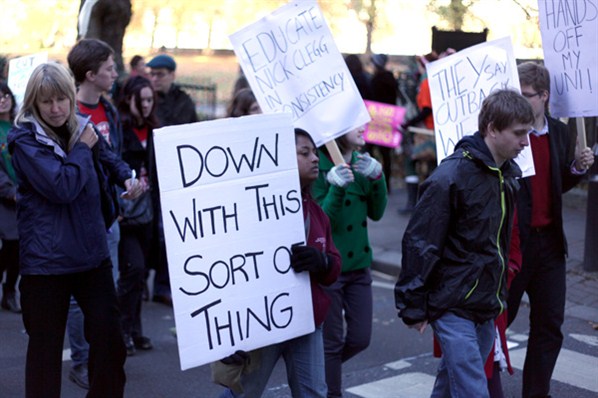
The London protests heat up (image courtesy Antony Bennison)
This week, Britain’s coalition government (narrowly) passed a proposal to dramatically hike university tuition fees, the results of which were a number of occasionally violent protests in central London. The Conservative party HQ, a modernist tower block at the edge of the Thames, was broken into and occupied by protesters, some of whom lobbed down fire extinguishers at the police below. Bottles were thrown at Prince Charles’s Rolls Royce as it sped through central London, smashing a window and leading to a proposal that he ditch the vehicle for his own safety (yes, that extreme). Protesters swung from the Union Jacks that hang from the Cenotaph, the war memorial near the Houses of Parliament. Graffitied cocks disfigured the public statues. In the frosty morning light, Parliament square looked like a cross between Helmand and Glastonbury.
The problem with protests of this sort is that it’s all too easy to take binary political positions that caricature the opposition or romanticize the nature of the thing. Plenty of the protesters weren’t, in fact, students, but it’s expedient for those who opposed the protests to describe them as such (thus, by lazy association, belittling the seriousness of their position). It’s also useful that there is a violent minority prepared to smash up police cars and spray genitalia on bus stops, so that resonant photographic images can be used as ballast for the opposition. On the other hand, many of the protesters seemed (judging by the slogans on banners ditched in bins or broken in the gutters) to see themselves as latter-day sans-culottes, for whom the issue of tuition fees was of a piece with the war in Iraq, the occupation of Palestine, and the creeping evils of capitalism, rather than being the misguided piece of legislation that it is. And yet the protests matter, and they matter for art and its future, and anyone with an interest in art ought to be taking a close interest.
The dramatic escalation of tuition fees in the UK – which represents a sudden spike, rather than the gradual increases in fees that have taken place in US universities – will hit arts courses particularly hard. Partly this is because, for fairly obvious reasons, prospective students from less well-off backgrounds will feel obliged to apply for vocational courses above anything perceived as academically frivolous. That’s a sad illustration of the wrongheaded belief – still parroted out by the ill-informed everywhere – that the only education worth having is a self-evidently practical one. That might have made sense amid the belching chimneys and lambchop sideburns of the Industrial Revolution, but it certainly doesn’t make sense in today’s climate. Yet that mindset continues to penalize the teaching of the arts (see Sir Ken Robinson’s talks on the subject for a far more eloquent discussion of the matter). All funding – all funding – has been slashed from colleges specializing in fine art, dance, music, and drama. Sit-in protests at Goldsmith’s College – at which, as Ben Davis points out in his excellent piece for Artinfo.com, a huge swath of the YBAs were trained, and can therefore be pinpointed as one of the breeding grounds for the resurgence of London as a global art capital in the nineties – continue, despite the funding decision having been made. A sit-in in Room 43 of the National Gallery on the 9th December, overlooked by Manet’s ferocious anti-colonial canvas, The Execution of Maximilian, had a pre-emptively desperate air. This is what’s at stake.
As Davis also suggests, the coincidental timing of the protests with the Miami art fairs couldn’t draw a more poignant parallel. He asks: “Which city was more important to the future of art last week, Miami or London?” And it’s pretty obvious what the answer is.
Sit-in at The National Gallery, December 2010